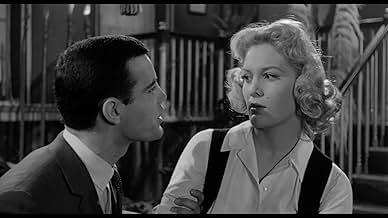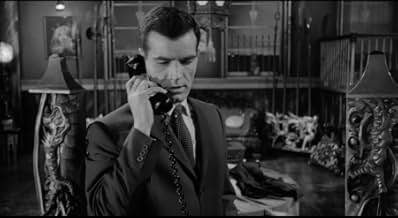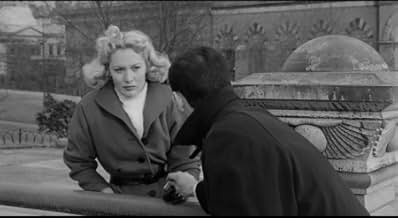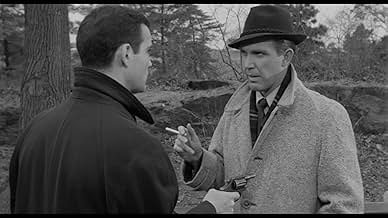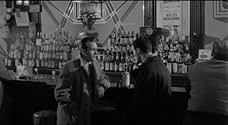A detective investigating the murder of a heroin addict discovers that there is a connection between the junkie and his fiancee, who is his boss' daughter.A detective investigating the murder of a heroin addict discovers that there is a connection between the junkie and his fiancee, who is his boss' daughter.A detective investigating the murder of a heroin addict discovers that there is a connection between the junkie and his fiancee, who is his boss' daughter.
- Director
- Writers
- All cast & crew
- Production, box office & more at IMDbPro
Featured reviews
B-movies are sometimes envisaged as an inferior kind of films. No, it means that the production costs are not as elevated as A-movies. If a star actor gets, say, 1 million dollars for a movie, well, some films (without stars) were made with an overall expenditure of less than 1 million. Now, I don't really care about production's costs, and some B-movies are better than the more high-class ones (not this one, I must say).
The strong positive values of "The Pusher", in my opinion, are the well-defined plot, without any confusing sub-plots or blurred images and shots that let you quite uncertain about what has really happened, and the consequent linear execution of it. This is also a detrimental point, because when you reach minute 16th (of the overall 82), you will know exactly how will the narrative develop.
No thrills, consequently, but if you are a lover of the genre you will enjoy this film. I rated it 6; let's say, more precisely, 6 and a half.
The strong positive values of "The Pusher", in my opinion, are the well-defined plot, without any confusing sub-plots or blurred images and shots that let you quite uncertain about what has really happened, and the consequent linear execution of it. This is also a detrimental point, because when you reach minute 16th (of the overall 82), you will know exactly how will the narrative develop.
No thrills, consequently, but if you are a lover of the genre you will enjoy this film. I rated it 6; let's say, more precisely, 6 and a half.
It's a tough look at the grimy side of New York, as the detectives of the 87th Precinct try to crack down on the drug trade.
It's based on Evan Hunter's '87th Precinct' series of novels. with the screenplay written by Harold Robbins. It's got a score by the great Raymond Scott, that varies from jazz to movie bombast -- I don't think it quite works, but you may reasonably disagree. Robert Lansing plays the same character he would in the 1961-1962 TV series, and if you look hard, you may recognize John Astin as one of the detectives in the background.
It's certainly worthy of approval of the tough realism of New York's street and worthy of your at
It's based on Evan Hunter's '87th Precinct' series of novels. with the screenplay written by Harold Robbins. It's got a score by the great Raymond Scott, that varies from jazz to movie bombast -- I don't think it quite works, but you may reasonably disagree. Robert Lansing plays the same character he would in the 1961-1962 TV series, and if you look hard, you may recognize John Astin as one of the detectives in the background.
It's certainly worthy of approval of the tough realism of New York's street and worthy of your at
Another reviewer complained that this wonderful, moody and atmospheric film about heroin addiction was too "dreary.." I have to laugh at some of the comments I read here. New York City, circa 1958; a heroin kingpin sets up shop, and sets himself up in a posh penthouse apartment on Riverside Drive. His customers are mostly kids, many of them Puerto Rican immigrants looking to find their place in a new city, and they get hooked on the smack that Mario supplies them. Things start to get out of control when a Police Lieutenant's daughter gets hooked, while working at a shady nightclub in Midtown. The pusher himself, played by Felice Orlandi, is suitably sleazy and heartless, as he feeds off of the young people in the area, making himself rich while destroying their lives in the process. This film is remarkably realistic in it's depiction of both the business aspect and the addiction aspect of the drug culture. Beautifully filmed in shadowy, stark black and white, with New York City on display in all it's old time glory. Of course it's "dreary," and seedy, and downbeat. This title is very rare and i imagine a copy must be a real collectors item. It reminded me of the New York beat/jazz scene described in Kerouac's "On the Road," so much so, that I half expected William Burroughs to appear in one of those seedy Times Square bars shown in this film. This is a wonderful, lost movie that should be easier to find. Similar to "Hatful of Rain," another early 60's NYC heroin movie, although this one is better. "The Pusher" would make a great double feature with "Who Killed Teddy Bear," which is another 1960's study of the seedy underbelly of New York's times Square scene. A lost gem...
Gene Milford did not build a household name, even in the realm of B productions like THE PUSHER . I have not seen anything else done by him, but THE PUSHER deserves above average rating.
One curiosity is that 1958 is the year that appears in the opening credits, but IMDB makes it 1960. Was in production for two years? It looks so shoestring that I doubt it, to be honest.
Albeit offering a generally realistic view of New York between those years, the film opens by introducing you to Lt Byrne, his wife, his daughter Laura, and the latter's boyfriend, Steve, also a copper. All, law abiding, all likable... but you discover very rapidly that Laura begins to stray, taking drugs on the quiet. She knows what she is doing, the dangers involved, the impact on her father and boyfriend, and she is convinced she can kick the habit but she just keeps diving deeper into it, getting her stuff from "Ganzo", another name for the pusher, who is very credibly played by prim and proper looking Felice Orlandi.
Of course, moral and family issues rise to the surface, and Lt Byrhe becomes extremely interested in the case when he gets what is happening with Laura and helps her with cold turkey treatment.
It makes you think that by 1958/1960 drug trafficking still seemed a minor and relatively containable problem, and yet since then even the finest police force in the world, US Police, has not managed to reduce it significantly, let alone stop it. And with new drugs being engineered full time, like crack, ecstasy, fentanyl, and all the rest of it, the common citizen has become more and more a target for the panoply of pushers, sellers, and others keeping that infamous trade ticking.
Sadly, by the time this well-meaning, honest film wrapped up, I could only think that mankind heeds no warning, however clear, and in the long run it is condemning itself to extinction for the sake of enriching drug lords.
Strong B noir photography by Arthur Ornitz, credible screenplay by Evan Hunter. 7/10.
One curiosity is that 1958 is the year that appears in the opening credits, but IMDB makes it 1960. Was in production for two years? It looks so shoestring that I doubt it, to be honest.
Albeit offering a generally realistic view of New York between those years, the film opens by introducing you to Lt Byrne, his wife, his daughter Laura, and the latter's boyfriend, Steve, also a copper. All, law abiding, all likable... but you discover very rapidly that Laura begins to stray, taking drugs on the quiet. She knows what she is doing, the dangers involved, the impact on her father and boyfriend, and she is convinced she can kick the habit but she just keeps diving deeper into it, getting her stuff from "Ganzo", another name for the pusher, who is very credibly played by prim and proper looking Felice Orlandi.
Of course, moral and family issues rise to the surface, and Lt Byrhe becomes extremely interested in the case when he gets what is happening with Laura and helps her with cold turkey treatment.
It makes you think that by 1958/1960 drug trafficking still seemed a minor and relatively containable problem, and yet since then even the finest police force in the world, US Police, has not managed to reduce it significantly, let alone stop it. And with new drugs being engineered full time, like crack, ecstasy, fentanyl, and all the rest of it, the common citizen has become more and more a target for the panoply of pushers, sellers, and others keeping that infamous trade ticking.
Sadly, by the time this well-meaning, honest film wrapped up, I could only think that mankind heeds no warning, however clear, and in the long run it is condemning itself to extinction for the sake of enriching drug lords.
Strong B noir photography by Arthur Ornitz, credible screenplay by Evan Hunter. 7/10.
This low-budget, independent picture's most significant point of interest is its writing pedigree -- it's based on a novel by hard-boiled favorite Ed McBain, with a screenplay by the best-selling novelist Harold Robbins. This contributes to a very schizophrenic result. The influence of the former is obvious in the police procedural framework, with some interesting shot-on-location scenes in Spanish Harlem and other NYC locales. The latter's heavy hand is apparent in the overblown melodramatic scenes which especially mar the last couple of reels.
The story concerns a police detective who, while investigating the apparent suicide of a young Puerto Rican heroin addict, discovers that his middle-class daughter is involved in the same underworld. The parallels/contrasts between the white-bread girl and the poverty stricken ethnic types gives this exposé its main social significance -- presaging similar scenes in much more accomplished films like "Traffic". But of course, the good-girl-gone-bad scenario was a staple of old-time exploitation pix way back in the days of silent movies and Dwain Esper.
Unfortunately, the filmmakers, though competent enough for the most part, really have no sense of style or tension, and the film just staggers monotonously from sequence to sequence. It only comes to life during the scenes with a feisty Latin cabaret dancer (the boy's sister), and in the character of the slick pusher who lures the girls into a life of addiction and takes advantage of them in his Playboy-style bachelor pad. Though the subject matter was probably sensational at the time, most modern viewers will find the dramatic scenes clichéd and unsubtle, and the action scenes clumsy. The jazzed-up version of "Billy Boy" that reverberates on the soundtrack is a futile attempt at hipness.
The director was a top-notch Hollywood editor, but this was his only session at the helm of a movie. Watch for some absurdly intense, method-style emoting by the young actors playing gang members.
The story concerns a police detective who, while investigating the apparent suicide of a young Puerto Rican heroin addict, discovers that his middle-class daughter is involved in the same underworld. The parallels/contrasts between the white-bread girl and the poverty stricken ethnic types gives this exposé its main social significance -- presaging similar scenes in much more accomplished films like "Traffic". But of course, the good-girl-gone-bad scenario was a staple of old-time exploitation pix way back in the days of silent movies and Dwain Esper.
Unfortunately, the filmmakers, though competent enough for the most part, really have no sense of style or tension, and the film just staggers monotonously from sequence to sequence. It only comes to life during the scenes with a feisty Latin cabaret dancer (the boy's sister), and in the character of the slick pusher who lures the girls into a life of addiction and takes advantage of them in his Playboy-style bachelor pad. Though the subject matter was probably sensational at the time, most modern viewers will find the dramatic scenes clichéd and unsubtle, and the action scenes clumsy. The jazzed-up version of "Billy Boy" that reverberates on the soundtrack is a futile attempt at hipness.
The director was a top-notch Hollywood editor, but this was his only session at the helm of a movie. Watch for some absurdly intense, method-style emoting by the young actors playing gang members.
Did you know
- TriviaFilm debut of John Astin.
- ConnectionsFeatured in Frightful Movie: The Pusher (1968)
Details
- Release date
- Country of origin
- Official site
- Language
- Also known as
- Narkotika
- Filming locations
- 113 East 115 Street, New York City, New York, USA(Location where Anibal Hernandez's Body was found by Police)
- Production company
- See more company credits at IMDbPro
Box office
- Gross US & Canada
- $1,656
- Opening weekend US & Canada
- $1,656
- May 9, 1999
- Gross worldwide
- $1,656
- Runtime1 hour 21 minutes
- Color
- Sound mix
- Aspect ratio
- 1.37 : 1
Contribute to this page
Suggest an edit or add missing content


